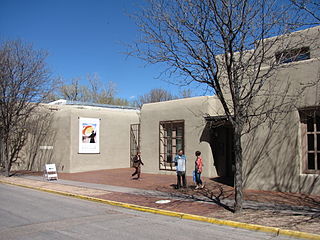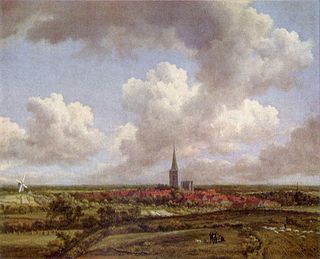
Canyon is a city in, and the county seat of, Randall County, Texas, United States. The population was 13,303 at the 2010 census. It is part of the Amarillo, Texas, metropolitan statistical area. Canyon is the home of West Texas A&M University and Panhandle–Plains Historical Museum, and the outdoor musical drama Texas.

Palo Duro Canyon is a canyon system of the Caprock Escarpment located in the Texas Panhandle near the cities of Amarillo and Canyon. As the second-largest canyon in the United States, it is roughly 120 mi (190 km) long and has an average width of 6 mi (9.7 km), but reaches a width of 20 mi (32 km) at places. Its depth is around 820 ft (250 m), but in some locations, it increases to 1,000 ft (300 m). Palo Duro Canyon has been named "The Grand Canyon of Texas" both for its size and for its dramatic geological features, including the multicolored layers of rock and steep mesa walls, which are similar to those in the Grand Canyon. It is part of Palo Duro Canyon State Park.

Georgia Totto O'Keeffe was an American modernist artist. She was known for her paintings of enlarged flowers, New York skyscrapers, and New Mexico landscapes. O'Keeffe has been called the "Mother of American modernism".

Kemper Museum of Contemporary Art opened in 1994 in Kansas City, Missouri. With a $5 million annual budget and approximately 75,000 visitors each year, it is Missouri's first and largest contemporary museum.

Elaine Marie Catherine de Kooning was an Abstract Expressionist and Figurative Expressionist painter in the post-World War II era. She wrote extensively on the art of the period and was an editorial associate for Art News magazine.

The Georgia O'Keeffe Museum is dedicated to the artistic legacy of Georgia O'Keeffe, her life, American modernism, and public engagement. It opened on July 17, 1997, eleven years after the artist's death. It comprises multiple sites in two locations: Santa Fe, New Mexico, and Abiquiu, New Mexico. In addition to the founding Georgia O'Keeffe Museum in Santa Fe, the O'Keeffe includes: the Library and Archive within its research center at the historic A.M. Bergere house; the Education Annex for youth and public programming; Georgia O'Keeffe's historic Abiquiu Home and Studio; the O'Keeffe Welcome Center in Abiquiu; and Museum Stores in both Santa Fe and Abiquiu. Georgia O'Keeffe's additional home at the Ghost Ranch property is also part of the O'Keeffe Museum's assets, but is not open to the public.

In art, a cloudscape is the depiction of a view of clouds or the sky. Usually, as in the examples seen here, the clouds are depicted as viewed from the earth, often including just enough of a landscape to suggest scale, orientation, weather conditions, and distance. The terms cloudscape and skyscape are sometimes used interchangeably, although a skyscape does not necessarily require a view of clouds.
Fujio Yoshida was a Japanese artist. She was the first female artist among the Yoshida family artists.

Oriental Poppies, also called Red Poppies, made by Georgia O'Keeffe in 1927, is a close-up of two papaver orientale that fills the entire canvas.

Georgia O'Keeffe made a number of Red Canna paintings of the canna lily plant, first in watercolor, such as a red canna flower bouquet painted in 1915, but primarily abstract paintings of close-up images in oil. O'Keeffe said that she made the paintings to reflect the way she herself saw flowers, although others have called her depictions erotic, and compared them to female genitalia. O'Keeffe said they had misconstrued her intentions for doing her flower paintings: "Well – I made you take time to look at what I saw and when you took time to really notice my flower you hung all your own associations with flowers on my flower and you write about my flower as if I think and see what you think and see of the flower – and I don't."

O’Keeffe at the University of Virginia, 1912–1914 is an exhibition of watercolors that Georgia O'Keeffe created over three summers in the early 20th century at the University of Virginia. Shown at the Georgia O'Keeffe Museum in Santa Fe, New Mexico, the exhibit opened November 4, 2016 and ran through September 10, 2017. A year later, on October 19, 2018, the exhibition opened at the Fralin Museum of Art on the grounds of the University of Virginia, where it remained on display until January 27, 2019.

Charcoal drawings by Georgia O'Keeffe from 1915 represents Georgia O'Keeffe's first major exploration of abstract art and attainment of a freedom to explore her artistic talents based upon what she felt and envisioned. O'Keeffe developed radical charcoal drawings, with just a few lines, that led to greater development of total abstraction. This series of works was completed following three summers of instruction at the University of Virginia on Arthur Wesley Dow's design philosophies, which were highly influential in her development as an abstract artist. Early the following year, photographer and art dealer, Alfred Stieglitz exhibited some of the drawings at his 291 art gallery.
Light Coming on the Plains is the name of three watercolor paintings made by Georgia O'Keeffe in 1917. They were made when O'Keeffe was teaching at West Texas State Normal College in Canyon, Texas. They reflect the evolution of her work towards pure abstraction, and an early American modernist landscape. It was unique for its time. Compared to Sunrise that she painted one year earlier, it was simpler and more abstract.

The Flag is a painting by Georgia O'Keeffe (1918), that represents her anxiety about her brother being sent to fight in Europe during World War I, a war that was particularly controversial and dangerous due to its use of new modern weapons and tactics, like the machine gun, mustard gas, naval mines and torpedoes, high-powered artillery guns, and combat aircraft. Due to government restrictions on the freedom of speech included in the Espionage Act of 1917 the painting was not displayed until 1968. It is in the collection of the Milwaukee Art Museum.
The early works of American artist Georgia O'Keeffe are those made before she was introduced to the principles of Arthur Wesley Dow in 1912.

Black Iris, sometimes called Black Iris III, is a 1926 oil painting by Georgia O'Keeffe. Art historian Linda Nochlin interpreted Black Iris as a morphological metaphor for female genitalia. O'Keeffe rejected such interpretations in a 1939 text accompanying an exhibition of her work by writing: "Well—I made you take time to look at what I saw and when you took time to really notice my flower you hung all your own associations with flowers on my flower and you write about my flower as if I think and see what you think and see of the flower—and I don't." She attempted to do away with sexualized readings of her work by adding a lot of detail.

Blue is the name of four paintings that Georgia O'Keeffe made in 1916. It was one of the sets of watercolors that she made exploring a monochromatic palette with designs that were non-representational of specific objects. The paintings were made on 15+7⁄8-by-11-inch sheets of Japanese tissue of the gampi tree.

Georgia O'Keeffe created a series of paintings of skyscrapers in New York City between 1925 and 1929. They were made after O'Keeffe moved with her new husband into an apartment on the 30th floor of the Shelton Hotel, which gave her expansive views of all but the west side of the city. She expressed her appreciation of the city's early skyscrapers that were built by the end of the 1920s. One of her most notable works, which demonstrates her skill at depicting the buildings in the Precisionist style, is the Radiator Building—Night, New York, of the American Radiator Building.
Gina Knee Brook, née Gina Schnauffer, and better known as Gina Knee, (1898–1982), was a twentieth century American artist. She lived and worked in New Mexico, the American South and Long Island, New York.
Ida Ten Eyck O'Keeffe was an American visual artist known for oil paintings, watercolors, and monotypes. She was the younger sister of painter Georgia O'Keeffe.



















